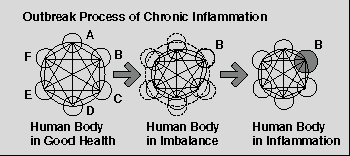 |
 |
|
|
|
 |
III. Inflammation 2/4
What is chronic inflammation? |
|
|
|
|
|
|
2. Theoretical Analysis of Chronic Inflammation
Next, let us consider how a tissue causes chronic inflammation. Because atrophic change is one of the representative pathological changes seen in chronic inflammation, begin by considering theoretically how a tissue causes atrophic change. Then, by using the conclusion, let us find out the special characteristics of chronic inflammation.
(a) Outbreak Mechanism of Atrophic Change
A tissue with chronic inflammation tends to decrease its own volume; this phenomenon can be considered to occur by the opposite mechanism to swelling change. Specifically, a tissue can theoretically be considered to cause atrophic change through two steps. At the first step, a tissue with chronic inflammation reduces the momentum relatively to the background tissues, and loses the balance in energy density with the background tissues. At the next step, to neutralize the imbalance in energy density, the tissue increases the energy density by decreasing the volume. As a result, the tissue becomes atrophied. (Notice that when a system decreasing the momentum reduces the energy density, it decreases the volume to raise the energy density.) |
|
|
|

|
|
(When a tissue reduces the momentum, it causes the imbalance in energy density. Then the tissue decreases the volume in order to neutralize the imbalance. Through this process, a tissue becomes atrophied.) |
|
|
|
In general, a tissue shows atrophic change when it is in the end stage of chronic inflammation. When a tissue causes inflammation for a long time, it gradually destroys the cells and decreases the momentum. By this mechanism, when the tissue maintains the volume, it will also decrease the energy density. As a result, the tissue decreases its volume in order to raises the energy density. Usually a tissue causes atrophic change through this process. |
|
|
|
(b) Outbreak Mechanism of Chronic Inflammation
Next, let us consider how a tissue causes chronic inflammation. The explanation above does not yet explain why a tissue with chronic inflammation continues causing inflammation, so let us next analyze theoretically how a tissue causes chronic inflammation.
The important point is to notice the fact that the fundamental cause of chronic inflammation usually originates in the background field of an organ. Always when a tissue shows strong change, it appears to cause it for itself. However, a tissue often causes inflammation due to the background field; this type of inflammation frequently occurs as chronic inflammation. Specifically, when the background field of a tissue changes the momentum, it causes the imbalance in momentum with the tissue. Then, in order to neutralize the imbalance, the tissue causes inflammation. If medical doctors can notice this mechanism, they will be able to treat this inflammation completely and stop changing it into chronic one. |
|
|
|

|
|
(A tissue causes chronic inflammation by the background field. In the figures above, when background tissues of tissue-B simultaneously reduce the momenta, they cause the imbalance in momentum with tissue-B. Then, to neutralize this imbalance, tissue-B causes inflammation.) |
|
|
|
Consider in detail why this type of disease usually occurs as chronic disease? The major reason for this originates in the fact that modern medical science does not have a concept: a tissue causes disease by the background field, so that it has no treatment of completely controlling this type of inflammation. As a result, when a tissue causes this type of inflammation, it tends to continue causing it for a long time. That is, medical doctors do not notice that the fundamental cause of this inflammation originates in the background field of a tissue, and cannot treat this inflammation completely. This is the different point in mechanism between acute and chronic inflammation. |
|
|
|
(c) Why does a tissue cause inflammation when the background field changes the momentum?
The reason for this originates in the relative difference in volume between a tissue and the background field. In general, a tissue has small volume compared with that of the background field. In addition, a human body is a relative system consisting of organs (tissues). Thus, when the background of a tissue changes the momentum, it causes the relative difference in momentum with the tissue. This relative difference in momentum works as a force, which oppresses the tissue and changes its momentum. |
|
|
|